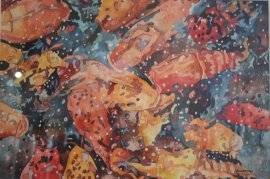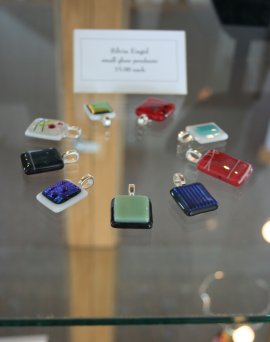 Artists
Ralph Iaccarino and Silvia Engel are wonderfully matched in an
attractive show at the MidCoast Fine Arts Gallery at the Mississippi
Valley Welcome Center in LeClaire. Iaccarino paints light and musical
colors in a flat space, while Engel works in a shallow space with
luminescent three-dimensional colors.
Artists
Ralph Iaccarino and Silvia Engel are wonderfully matched in an
attractive show at the MidCoast Fine Arts Gallery at the Mississippi
Valley Welcome Center in LeClaire. Iaccarino paints light and musical
colors in a flat space, while Engel works in a shallow space with
luminescent three-dimensional colors.
Engel is showing beautiful and lovely creations of glowing, multi-hued fused-glass pendants and earrings, which are displayed flatly in the gallery's three glass cases. They are really meant to be seen and touched and held up to the light.
Accompanying her on the walls is Iaccarino. He is well known in our area for his rich, colorful watercolors of brightly flowered images of Costa Rican landscapes; his music; his "Creators" segments on WQPT; and his art-teaching videos for children.
But his true calling lies in combining musical chords of colors inside plant-like forms under a clear equatorial light that undulates and permeates his images. They give off a romantic, radiant, mysterious, and beautiful glow, with a shimmering movement of color that captures the eye. He uses the contours and forms of nature to create another world, which both delights and relaxes. Everything is clean and unhurried, without seeming effort, in a lively and baroque manner.
Iaccarino's technique of layering and placing color forms next to other color forms is a musical technique. His individual areas of mixed, textured, and surprising color combinations act like little musical chords. When combined with nearby areas, these grow and cover the whole piece, yet Iaccarino arranges all these colors harmoniously, without muddle or loss of concentration.
He begins his watercolors with a loose line drawing in pencil, lightly sketching the outlines of the image into a flat space from one of his photographs. With little natural depth of field, the colors tend to form patterns rather than show objects in space.
He often uses black gouache (the brother of watercolor) to lay in solid dark backgrounds, giving a strong contrast, when needed, to the watercolor's transparency.
While the painting is still wet, he lightly sprinkles salt onto some of the surface, absorbing the watercolor and leaving a new and uneven texture to the area. The effect is a syncopation of little drumbeats on the surface.
But Iaccarino's best work comes when he improvises off the beautiful lines of natural plant forms in this slender painted space.
A good example of this is his Blue Moon Bromeliad, of overlapping iris-shaped forms. They look like luxuriant flowers, and then they do not. There is an excellent play between the real and imagined or unexpected, in which colors both describe the flowers and also suggest their ever-changing appearance - in the wind, in their constant growth, and in the transforming viewer.
The same ideas can be found in Boyd's Lilies, in which opening and blooming flowers are packed together in a thick arrangement of colorful forms that interconnect and harmonize with each other. The air in this work is fragrant and luminous, energetic and romantic.
A sense of calm emerges from the images, even when they are the most busy. In the two Aquatic Rush Hour pieces, we realize, after a few seconds, that we are looking down into a pool or stream full of large goldfish, dozens of them, overlapping and brimming with color. The transparent blue water around the fish is also filled with colors, shadowed or reflected, filling the areas like a fragrance in a room.
The eye gazes at one combination of colors and fish, and then is pulled by peripheral vision to flashes of colors from other fish. Each part is interesting in itself. But when we step back to see the full image, in this rush of colors everything combines into a soothing, blending, harmonious feeling.
Edith Piaf, the great French cabaret singer, was said to sing directly from the heart to her voice. Iaccarino does this too, but to the eye. His visual expressions are informed by his musical and spiritual view of life that flows naturally into his paintings.
 The
translation of an artist's vision to the final effect occurs through
technique. But as an artist progresses in skill, the line between
thinking about how a piece is going to be made and its actual making
becomes thinner, to the point where the work streams directly out of,
or through, the artist. After a creator has developed a strong
technique, it will naturally express whatever he or she is thinking
or feeling along the way, including the artist's inner layers.
The
translation of an artist's vision to the final effect occurs through
technique. But as an artist progresses in skill, the line between
thinking about how a piece is going to be made and its actual making
becomes thinner, to the point where the work streams directly out of,
or through, the artist. After a creator has developed a strong
technique, it will naturally express whatever he or she is thinking
or feeling along the way, including the artist's inner layers.
In his watercolor series Itabo Blankets, the artist starts with the patterns of blankets in a flat space that recede ever so slightly into real space. Then he dramatically slices through the underlying patterns with long plant forms, like a solo guitar playing over a colorful and rhythmic musical bed. He combines the seen with the imagined, and the realistic with the magical, through his intuition, experience, and love of color.
With Morning of Negotiation, he paints two differet wood-armed, soft-backed chairs, between them a small table with a plant. Behind the chairs we see low seats by a large window, a place for a small Greek chorus to comment on the drama. On each side, long curtains are pulled back to allow the light in. Balance and harmony are achieved in the work by the composition, by the softness of the light, and by the muted colors of the fabric.
Silvia Engel, the worthy accompanying artist in this exhibit, is showing beautiful fused-glass pendants and earrings.
The kiln-fired colors are fabulous - iridescent and glowing - in rich combinations of melted glass, created in her studio (Mi Tierra Designs) in Maquoketa, Iowa. There is a shimmering movement in the layered colors that captures the eye. They delight and relax.
Growing up in Mexico surrounded by families of artists, she has continued her artistic growth here in our area, often returning to her little town, near silver-rich Taxco, for buying and collecting journeys.
Her shapes are loosely rectangular and abstract, overlapping, mysterious, with landscape-like layers of textured and surprising colors of glass, in a compact form meant to be worn. They change beautifully in any light, according to the luminosity of the day or evening.
Their effect is striking and radiant, welcoming us into them like a lustrous little town seen from a shadowed hill at night in the tropics.
Although seeing the exhibit involves a short but pleasant journey driving up along the river to LeClaire, your reward will be a time well-spent with beautiful colors, glimmering light, and appealing forms that refresh and inspire.










